2017重庆教师招聘面试指导:小学英语说课稿
教师入编面试小学英语全英文说课稿

教师入编面试小学英语全英文说课稿第一篇:教师入编面试小学英语全英文说课稿Good morning/afternoon, everyone.My name is XXX.My number is XXX.I‟m so honored and pleasure to have the chance to be here sharing my lesson with you.The teaching material I choose to illustrate is taken from XXX.My teaching plan will include 5 parts: the analysis of teaching material, teaching aims, the important and difficult point, teaching methods and teaching procedure.Part 1 Analysis of teaching material This unit introduces and develops the theme of “XXX”, Ss are expected to master the new words(……)and to use the sentence patterns(……)in proper situation.The teaching material mainly describes(……), and it shows all of the new knowledge points.Therefore, it is in the important position of this unit.If Ss can master it well, it will be benefit for them to learn the rest of the unit.Part 2 Teaching aims According to the new curriculum standard and the syllabus, and after studying the teaching material and the facts of the Ss, I set the teaching aims as follows: 1, Knowledge objects 1)Ss can understand the content correctly.They can read and play the dialogue;2)Ss can listen, read, say and spell the core words(……);3)Ss can use the sentence patterns(……)properly.2, Ability objects 1)To train Ss‟ abilities of listening and speaking;2)To train Ss‟abulity of working in groups.3, Moral objects To foster Ss‟conciousness of good cooperation and proper competition.Part 3 Important and difficult points According to the syllabus,the important points: have Ss fully understand the content, help them to read and play the dialogue.The difficult points: 1)Help Ss to read the dialogue fluently, and help them to read and play the dialogue;2)makesure they can read the core words correctly.Part 4 Teaching methods Well, how to achieve the teaching aims, stress the important points and break through the difficult points? The key is to make use of the proper teaching methods.Ss are expected to learn in real situation, so I will use some pictures, words, sentence cards and body language to help them get a better understanding of the content.A tape recorder and multi-media computer will help me to achieve the aims.The Task-based teaching method, Communcative teaching method and Group cooperation teaching method will be used in this period.Part 5 Teaching procedure In order to realize the teaching procedure properly and effiently, and under the princi ple of …student centered‟, I divide the teaching procedure into 5 steps: Step 1 Lead-in I will play a English song for Ss and have a free talk related to this period with them.Purpose : to attract Ss‟attention and conduct the atmosphere of English learning.Step 2 Presentation 1)As we all know ,the substance of English is communication and the environment of communication is life.So before I present the dialogue, I‟ll creat a real situation for Ss to speak English freely and happily.Purpose: This task will arouse Ss ‟interest and encourage them to ask questions with new knowledge.2)Guide Ss‟ attention to the dialogue, and have them read the dialogue individually to get the main idea.Ss are expected to answer some questions related to the new words.In this way, the new words are taught.Meanwhile I‟ll stick the sentence patterns on the Bb.Ss need to practise the new words and sentence patterns in different ways.Purpose : It will be much easier and clear for Ss to accept the new language points.Proper practice is benefit for consolidation.Step 3 Practice I will ask Ss to listen to the tape and encourage them to imitate to read andsay.They will read in different roles and in pairs, then try to recite the text.Guide them pay attention to the pronunciation and intonation.Purpose;to train Ss‟ abilities of listening and speaking and their good sense of English language.Step 4 Consolidation There are lots of ways to consolidate the new knowledge, playing game is a good way.So in this step, I will play a cartoon with no voice for Ss, and ask them to make the dialogue.According to the physiology of Ss, I‟ll hold a group competition during the game, and ask them to finish the blanks.Purpose: this task is designed to stress Ss‟ position of host in class.It can arouse Ss‟ interest.Also it will help Ss to develop good habits and achieve theirs goals of mastering the learnt knowledge.Step 5 Extention Is this the end of the class? I don‟t think so.If there‟s an end, I think it should be in real life.So the step 5 is necessary.I‟ll encourage Ss to use what they have learnt in class to communicate with each other in real life.This will also be as their homework.As for the Bb, it mainly about the new words and sentence patterns.In a word, the whole period is designed for easy steps to steps that are challenging.It will be benefit for Ss to acquire information, knowledge, and their abilities and skills will be well trained.That‟s all.Thanks so much for your attention.第二篇:教师入编面试小学英语全英文说课稿Good morning/afternoon, everyone.My name is XXX.My number is XXX.I‟m so honored and pleasure to have the chance to be here sharing my lesson with you.The teaching material I choose to illustrate is taken from XXX.My teaching plan will include 5 parts: the analysis of teaching material, teaching aims, the important and difficult point, teaching methods and teaching procedure.Part 1 Analysis of teaching material This unitintroduces and develops the theme of “XXX”, Ss are expected to master the new words(……)and to use the sentence patterns(……)in proper s ituation.The teaching material mainly describes(……), and it shows all of the new knowledge points.Therefore, it is in the important position of this unit.If Ss can master it well, it will be benefit for them to learn the rest of the unit.Part 2 Teaching aims According to the new curriculum standard and the syllabus, and after studying the teaching material and the facts of the Ss, I set the teaching aims as follows: 1, Knowledge objects 1)Ss can understand the content correctly.They can read and play the dialogue;2)Ss can listen, read, say and spell the core words(……);3)Ss can use the sentence patterns(……)properly.2, Ability objects 1)To train Ss‟ abilities of listening and speaking;2)To train Ss‟abulity of working in groups.3, Moral objects To foster Ss‟conciousness of good cooperation and proper competition.Part 3 Important and difficult points According to the syllabus,the important points: have Ss fully understand the content, help them to read and play the dialogue.The difficult points: 1)Help Ss to read the dialogue fluently, and help them to read and play the dialogue;2)make sure they can read the core words correctly.Part 4 Teaching methods Well, how to achieve the teaching aims, stress the important points and break through the difficult points? The key is to make use of the proper teaching methods.Ss are expected to learn in real situation, so I will use some pictures, words, sentence cards and body language to help them get a better understanding of the content.A tape recorder and multi-media computer will help me to achieve the aims.The Task-based teaching method, Communcative teaching method and Group cooperation teaching method will be used in this period.Part 5Teaching procedure In order to realize the teaching procedure properly and effiently, and under the principle of …student centered‟, I divide the teaching procedure into 5 steps:Step 1 Lead-in I will play a English song for Ss and have a free talk related to this period with them.Purpose : to attract Ss‟attention and conduct the atmosphere of English learning.Step 2 Presentation 1)As we all know ,the substance of English is communication and the environment of communication is life.So before I present the dialogue, I‟ll creat a real situation for Ss to speak English freely and happily.Purpose: This task will arouse Ss ‟ interest and encourage them to ask questions with new knowledge.2)Guide Ss‟ attention to the dialogue, and have them read the dialogue individually to get the main idea.Ss are expected to answer some questions related to the new words.In this way, the new words are taught.Meanwhile I‟ll stick the sentence patterns on the Bb.Ss need to practise the new words and sentence patterns in different ways.Purpose : It will be much easier and clear for Ss to accept the new language points.Proper practice is benefit for consolidation.Step 3 Practice I will ask Ss to listen to the tape and encourage them to imitate to read and say.They will read in different roles and in pairs, then try to recite the text.Guide them pay attention to the pronunciation and intonation.Purpose;to train Ss‟ abilities of listening and speaking and their good sense of English language.Step 4 Consolidation There are lots of ways to consolidate the new knowledge, playing game is a good way.So in this step, I will play a cartoon with no voice for Ss, and ask them to make the dialogue.According to the physiology of Ss, I‟ll hold a group competition during the game, and ask themto finish the blanks.Purpose: this task is designed to stress Ss‟position of host in class.It can arouse Ss‟ interest.Also it will help Ss to develop good habits and achieve theirs goals of mastering the learnt knowledge.Step 5 Extention Is this the end of the class?I don‟t think so.If there‟s an end, I think it should be in real life.So the step 5 is necessary.I‟ll encourage Ss to use what they have learnt in class to communicate with each other in real life.This will also be as their homework.As for the Bb, it mainly about the new words and sentence patterns.In a word, the whole period is designed for easy steps to steps that are challenging.It will be benefit for Ss to acquire information, knowledge, and their abilities and skills will be well trained.That‟s all.Thanks so much for your attention.第三篇:小学英语全英文说课稿小学英语全英文说课稿模板教学2009-08-31 09:00阅读580评论0字号:大中小Background of English teaching in primary school: It is not a long history that English is as a subject in primary school in our country and the main instructional aims of teaching English in primary school is to cultivate pupils’ basic abilities of their listening and speaking and their good sense of the English language.Our boys and girls are exposed to English for the first time, so it is very important to develop their keeninterest in English.I.Contents:Today I’m going to talk about Part B of Unit 2, PEP Primary English, Book 3.This lesson includes two parts: Let’s talk and let’s practice.In section 1, it mainly deals with the dialogueabout “What’s in the schoolbag?” and the answers.And in section 2, it provides a real situation for the Ss to prastise the pattern: How many +n.(pl.)+ do you have? And the answer: I have 23 +n.(pl.)II.Teaching aims1.Aims on the knowledge(1)To enable the Ss to understand and speak: “My schoolbag is heavy.What’s in it? Thank you sooooooo much.” Make sure that Ss can use these sentences in real situations.(2)To help Ss to finish the survey.(3)Let Ss finish the assessment of “Let’s check” in this unit.2.Aims on the abilities(1)To develop Ss’ abilities of listening and speaking.(2)To train the Ss’ ability of working in groups.(3)To foster Ss’ abilities of communication and their innovation.3.Aims on the emotion(1)To foster Ss’ consciousness of good co-operation and proper competition.(2)T o lead Ss to show their loveliness to the poor.III.Key-points of this lesson(1)To help Ss ask and answer the question: What’s in it?(2)To enable Ss to study in groups and co-operate skillfully.(3)T o develop Ss’ interest in English.IV.Difficult points(1)To help the Ss ask and answer the question “What’s in it?” and make sure they can use the plural nouns correctly.(2)To finish the survey by themselves.V.Teaching methodsAs we all know: the main instructional aims of learning English in primary school is to cultivate pupils’ basic abilities of listening and speaking and their good sense of the English language.So in this lesson I’ll mainly use “Task-based” teaching method.That is to say, I will let the Ss learn in real situations, finish a task by making a survey to help the Ss to geta better understanding of the key structure of the dialogue.I will arrange four kinds of activities: singing, guessing game, finishing a survey and having a competition.And in this lesson a recorder, CAI, school things and a printed form will beneeded.Students should prepare some school things.VI.Teaching procedures and purposes of my designing.I’ll finish this lesson in five steps.Step 1.Warm-up and preview1.Free talk between T and Ss about things in the classroom.2.Sing the song together: Books and pencils.3.Do some TPR, for example: Show me your English book.Show me your crayon.4.Review the numbers by asking: “How many crayons do you have?”Purpose: It is important to form a better English learning surrounding for the Ss by singing and doing some total physical response and at the same time it provides situations to review learned knowledge for the next step.Step 2.Presentation Now I’ll mainly talk about this step.1.Present the pattern: “My schoolbag is heavy.” “What’s in it?.”(1)Show a bag and say: “Look!I have a bag.” Carry it and say: “Oh, it is heavy.My schoolbag is heavy.” Help the Ss understand the meaning with the help of my body language.Then lead the Ss to read the sentence.Make sure they can say it correctly.(2)T: My schoolbag is heavy.Open the bag and say: “What’s in it? What’s in my schoolbag?”Take out a Chinese book.Then do the action again.Let the Ss read the sentence.2.Play a guessing game.Divide the whole class into four groups to have a competition.Let them guess: What’s in the bag? How many? Purpose: T o present the key structures one by one is much easier for the Ss to learn and grasp themeanings.Proper competition can arouse the Ss’ interest in English learning.3.With the help of the CAI to present the dialogue.Set a situation to help Ss understand: Two Ss are coming.One girl is carrying a heavy bag on her back.They are talking.Girl: My schoolbag is heavy.Boy: What’s in it?Girl: 20 story-books, 32 pencil, 9 rulers, 12 crayons and 30 picture-books.Etc.Boy: What will you do?Girl: They are for the poor.Boy: Great!I’ll br ing some school things too.The boy comes back home and puts a lot of things into the bag.Then he goes to school again and gives them to a teacher.While he is taking them out, he is counting the numbers of all things.The teacher says: Thank you soooooooo much.4.Mention that we should take care of the poor.5.Play the cassette.Let the Ss listen and imitate the dialogue.Pay attention to their pronunciation and intonation.Purpose: CAI can provide a real situation for the Ss to understand the dialogue and the relationships between people better.Tell the Ss we should show our loveliness to the Ss.Step 3.PracticeDivide Ss into groups of six children.Each one would finish the printed form by asking and answering: How many storybooks do you have? Find out which group finishes faster.Story books picture-books sharpeners crayons pencils erasers pencil-cases rulers Chen Jie 8 24 3 32 26 4 1 3 Purpose: Task-based teaching method is used here to develop Ss’ ability of communication and also their ability of co-operation will be well trained.Step 4.AssessmentHelp Ss finish “Let’s check” of this unit and workbook.Purpose: To check the knowledge Ss have learned in this period.Step 5.Add-activity1.Let Ss tell each other how many school things they haveafter class.Tell their parents how many school things they have at home.2.Take care of everything they have.Purpose: Revision is so important that Ss should speak English as much as they as in class or after class.It is necessary for the Ss to do some extensive exercises after class to consolidate the knowledge they learned. 第四篇:小学英语全英文说课稿Good morning, dear judges!First, thank you for sharing your time to listen to my teaching ideas.Today I’m going to talk about Part B of Unit 2, PEP Primary English, Book 3.I design this lesson from 5 aspects, namely the analysis of teaching material, teaching methods, teaching aids, study methods and the teaching procedures.So first, let’s come to Part 1.analysis of teaching material.Analysis of teaching material.This lesson includes two parts: Let’s talk and let’s practice.In section 1, it mainly deals with the dialogue about “What’s in the schoolbag?” and the answers.And in section 2, it provides a real situation for the Ss to practice the pattern: How many +n.(pl.)+ do you have? And the answer: I have 23 +n.(pl.)Such a topic is related to daily life, so it is helpful to raise the learning interest of students and it will also help to improve their spoken English.So this unit forms connecting links with a special meaning in this book The teaching aims are established according to the New Curriculum of Primary School English.There are 3 kinds of aims here.Teaching aims 1.knowledge aims(1)To enable Ss to understand and speak five new words and two sentence patterns: … Make sure that Ss can use the se words and sentences in real situations.(2)To let ss be able to describe someone else more freely and vividly.2.Ability aims(1)To develop Ss’ abilities of listening and speaking.(2)To train the Ss’ ability of working in groups.(3)T o cultivate Ss’ abiliti es ofcommunication and their innovation.3.Moral aims(1)To foster Ss’ consciousness of good co-operation and proper competition.(2)T o cultivate Ss’ study motivation.Help them establish good study habit.Teaching key-points(1)To enable Ss to grasp the new words and help Ss ask and answer the question: What’s in it?(2)To enable Ss to study in groups and co-operate skillfully.Teaching difficulties1.To improve Ss’s speaking ability to describe others more freely2.To develop their lateral thinking through games.Part 2 teaching methods About the teaching methods, I will choose to adopt the communicative language teaching method, which encourages students to open their mouths to communicate.And game teaching method which can arouse ss’ interest as well as help them learn easily and happily and situational teaching method which is close to life and helps ss apply their knowledge.Part 3 Teaching aids In order to fully implement the above methods, such teaching equipments as pictures, cards, blackboard and multi-media are essentially to be used in my class.Part4 Study methods About study method, I will adopt cooperative learning method, which can create conditions and opportunities for ss to practice English, cooperate and learn from each other.Part 5 teaching procedures and purposes of my designing.I’ll finish this lesson in 7 steps.Step1:warming-up Free-talk first, and let ss act in front.They can make dialogues, say a chant, play a game ect.in groups.Then, say a chant together The purpose is to active the classroom atmosphere.It also helps Ss to review the things they’ve learned before.Step2: Leading-inI will show some pictures to lead in the topic The purpose is to arouse ss’ interest Step3: Present the new words I will presentthe new words through comparison of some pictures And I will put these pictures on the bb, and write their features to present the new words.Then make some sentences using the words, and do the chain game The purpose is to let ss understand the new words easily and intuitively Step4: Let’s learn 1.Let ss watch the flash on the screen, no words, the content is the let’s learn part.2.Help ss read after the flash.3.Let ss open the books and read after me.4.Let ss read together.5.Group work, to act the dialogue out.The purpose is to train ss’ abilities of listening and speaking, and ability of working in groups.The flash can help ss understand the sentence better.Step5: Let’s playAfter presenting the new words and new sentences, the students need some activities to practice them.Students love games so much.Games can create a cheerful and light-hearted environment and arouse students’ interest in learning English.So in this part, I prepare three games.And during games, ss can earn cards.And 30 cards, no homework.So games can also foster Ss’ cons ciousness of good co-operation and proper competition 1.Hide the hands: call student A to come to the front with his back to the rest.I will show sA a word card, as soon as his answer is correct, he can quickly turn around and find someone whose hands are still can be seen.2.Whisper: divide the ss into two groups, every group will whisper the same sentence, and see which group is correct and reporter: call one student to be the TV reporter, and ask two questions: Step6: Let’s talk I will create a situation: Obama is coming to visit our school, and he wants to know something about our school.Ask a student to be Obama, and he/ she can ask any questions he/ she anize Ss into groups of four and discuss “ how can you help them to find the missing person(situation: a little child islost in a shopping mall and he/she is trying to find his parent)This is to cultivate Ss’ abilities of communication and their innovation Step7: Sum up Review the words and sentences The purpose is to sum up what we have learnt today and strengthen Ss’ memory.For homework: describe your families And about the blackboard design, like I have said, I will put the pictures on the bb and write the features of each picture.第五篇:小学英语全英文说课稿Background of English teaching in primary school: It is not a long history that English is as a subject in primary school in our country and the main instructional aims of teaching English in primary school is to cultivate pupils’ basic abilities of their listening and speaking and their good sense of the English language.Our boys and girls are exposed to English for the first time, so it is very important to develop their keen interest in English.I.Contents:Today I’m going to talk about Part B of Unit 2, PEP Primary English, Book 3.This l esson includes two parts: Let’s talk and let’s practice.In section 1, it mainly deals with the dialogue about “What’s in the schoolbag?” and the answers.And in section 2, it provides a real situation for the Ss to prastise the pattern: How many +n.(pl.)+ do you have? And the answer: I have 23 +n.(pl.)II.Teaching aims1.Aims on the knowledge(1)To enable the Ss to understand and speak: “My schoolbag is heavy.What’s in it? Thank you sooooooo much.” Make sure that Ss can use these sentences in real situations.(2)To help Ss to finish the survey.(3)Let Ss finish the assessment of “Let’s check” in this unit.2.Aims on the abilities(1)To develop Ss’ abilities of listening and speaking.(2)To train the Ss’ abilityof working in groups.(3)To foster Ss’ abilities of com munication and their innovation.3.Aims on the emotion(1)To foster Ss’ consciousness of good co-operation and proper competition.(2)T o lead Ss to show their loveliness to the poor.III.Key-points of this lesson(1)To help Ss ask and answer the question: Wha t’s in it?(2)To enable Ss to study in groups and co-operate skillfully.(3)To develop Ss’ interest in English.IV.Difficult points(1)To help the Ss ask and answer the question “What’s in it?” and make sure they can use the plural nouns correctly.(2)To finish the survey by themselves.V.Teaching methodsAs we all know: the main instructional aims of learning English in primary school is to cultivate pupils’ basic abilities of listening and speaking and their good sense of the English language.So in this lesson I’ll mainly use “Task-based” teaching method.That is to say, I will let the Ss learn in real situations, finish a task by making a survey to help the Ss to get a better understanding of the key structure of the dialogue.I will arrange four kinds of activities: singing, guessing game, finishing a survey and having a competition.And in this lesson a recorder, CAI, school things and a printed form will be needed.Students should prepare some school things.VI.Teaching procedures and purposes of my designing.I’l l finish this lesson in five steps.Step 1.Warm-up and preview1.Free talk between T and Ss about things in the classroom.2.Sing the song together: Books and pencils.3.Do some TPR, for example: Show me your English book.Show me your crayon.4.Review the numb ers by asking: “How many crayons do you have?” Purpose: It is important to form a better English learning surrounding for the Ss by singing and doingsome total physical response and at the same time it provides situations to review learned knowledge for the next step.Step 2.Presentation Now I’ll mainly talk about this step.1.Present the pattern: “My schoolbag is heavy.” “What’s in it?.”(1)Show a bag and say: “Look!I have a bag.” Carry it and say: “Oh, it is heavy.My schoolbag is heavy.” Help the Ss underst and the meaning with the help of my body language.Then lead the Ss to read the sentence.Make sure they can say it correctly.(2)T: My schoolbag is heavy.Open the bag and say: “What’s in it? What’s in my schoolbag?” Take out a Chinese book.Then do the action again.Let the Ss read the sentence.2.Play a guessing game.Divide the whole class into four groups to have a competition.Let them guess: What’s in the bag? How many? Purpose: To present the key structures one by one is much easier for the Ss to learn and grasp the meanings.Proper competition can arouse the Ss’ interest in English learning.3.With the help of the CAI to present the dialogue.Set a situation to help Ss understand: Two Ss are coming.One girl is carrying a heavy bag on her back.They are talking.Girl: My schoolbag is heavy.Boy: What’s in it?Girl: 20 story-books, 32 pencil, 9 rulers, 12 crayons and 30 picture-books.Etc.Boy: What will you do? Girl: They are for the poor.Boy: Great!I’ll bring some school things too.The boy comes back home and puts a lot of things into the bag.Then he goes to school again and gives them to a teacher.While he is taking them out, he is counting the numbers of all things.The teacher says: Thank you soooooooo much.4.Mention that we should take care of the poor.5.Play the cassette.Let the Ss listen and imitate the dialogue.Pay attention to their pronunciation and intonation.Purpose: CAI can provide a real situation for the Ss tounderstand the dialogue and the relationships between people better.Tell the Ss we should show our loveliness to the Ss.Step 3.Practice Divide Ss into groups of six children.Each one would finish the printed form by asking and answering: How many storybooks do you have? Find out which group finishes faster.Story books picture-books sharpeners crayons pencils erasers pencil-cases rulers Chen Jie 8 24 3 32 26 4 1 3 Purpose: Task-based teaching method is used here to develop Ss’ ability of communication and also their ability of co-operation will be well trained.Step 4.Assessment Help Ss finish “Let’s check” of this unit and workbook.Purpose: To check the knowledge Ss have learned in this period.Step 5.Add-activity 1.Let Ss tell each other how many school things they have after class.Tell their parents how many school things they have at home.2.Take care of everything they have.Purpose: Revision is so important that Ss should speak English as much as they as in class or after class.It is necessary for the Ss to do some extensive exercises after class to consolidate the knowledge they learned.。
人教版小学英语教师招聘考试面试说课稿

人教版小学英语教师招聘考试面试说课稿work Information Technology Company.2020YEAR小学英语说课稿《Unit 3 Read and write》我说课的内容是小学PEP英语四年级下册Unit 3第三课时Read and write .我主要从说教材、教法、学法、教学过程、板书设计、说评价五个方面展开我的说课。
一:说教材第一小点.教学内容和地位本课时是本单元中的第三课时,是功能型、交际型的综合训练课,是学生在上节课的基础上继续深入学习red、 yellow 、green 、blue、 white五个颜色单词及句型I s this your T-shirt N o, it isn’t的运用和书写。
第二小点.教学目标我把本课时的教学目标设计如下:语言知识目标:1)五个颜色单词red yellow green blue white 的掌握和运用。
2)能对所属衣物进行提问及回答Is this your T-shirt No , it isn’t .3)能在图文和场景下进行简单的交流和表演。
4)正确在四线三格中书写单词和句子。
情感态度目标通过本课的学习使学生达到初步运用英语进行交际的能力,培养学生的合作精神和良好的书写习惯。
第三小点.教学重、难点我把本课的教学重、难点设置为1)颜色单词及句型在交际中的运用2)五个单词及句子在四线三格中的正确书写。
第四小点:教学准备在这一节课中我准备了服装、奖励学生的苹果、进行书写比赛的英语书写纸、工作证、卡片。
二:说教法、学法在教学活动中,我通过各种生动、形象、有趣的手段激发儿童的兴趣,在这一课时中我采用了实物直观法、情景法、多媒体辅助法和小组活动学习法,勤表扬,多鼓励,使学生掌握语言点,在以下的教学过程的各环节中我将会谈到这些教法、学法的运用和操作。
三:说教学过程我把教学过程分为四部分来完成。
即是热身--授课--操练--总结。
第一环节复习引入激发兴趣在热身环节中我选择播放Let’s do 部分的录音,学生站起来边跟唱边做动作,比如put on your T-shirt hang up your skirt take off your jacket wash your shirt。
小学英语面试说课稿子(共6篇)
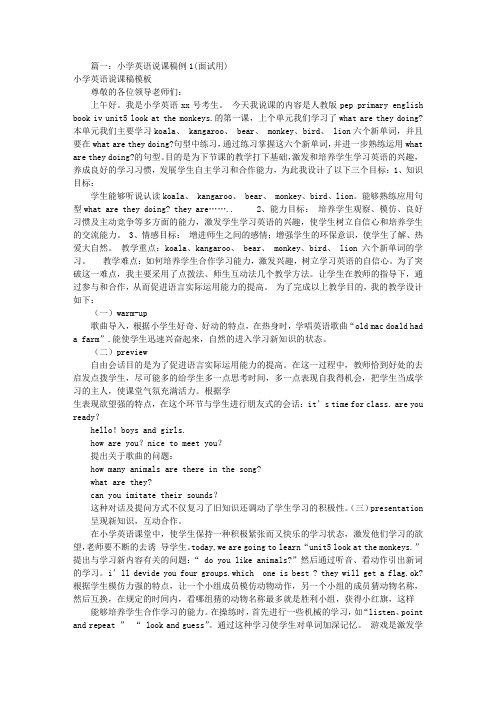
篇一:小学英语说课稿例1(面试用)小学英语说课稿模板尊敬的各位领导老师们:上午好。
我是小学英语xx号考生。
今天我说课的内容是人教版pep primary english book iv unit5 look at the monkeys.的第一课,上个单元我们学习了what are they doing?本单元我们主要学习koala、 kangaroo、 bear、 monkey、bird、 lion六个新单词,并且要在what are they doing?句型中练习,通过练习掌握这六个新单词,并进一步熟练运用what are they doing?的句型。
目的是为下节课的教学打下基础,激发和培养学生学习英语的兴趣,养成良好的学习习惯,发展学生自主学习和合作能力,为此我设计了以下三个目标:1、知识目标:学生能够听说认读koala、 kangaroo、 bear、 monkey、bird、lion。
能够熟练应用句型what are they doing? they are…….. 2、能力目标:培养学生观察、模仿、良好习惯及主动竞争等多方面的能力,激发学生学习英语的兴趣,使学生树立自信心和培养学生的交流能力。
3、情感目标:增进师生之间的感情;增强学生的环保意识,使学生了解、热爱大自然。
教学重点:koala、kangaroo、 bear、 monkey、bird、 lion六个新单词的学习。
教学难点:如何培养学生合作学习能力,激发兴趣,树立学习英语的自信心。
为了突破这一难点,我主要采用了点拨法、师生互动法几个教学方法。
让学生在教师的指导下,通过参与和合作,从而促进语言实际运用能力的提高。
为了完成以上教学目的,我的教学设计如下:(一)warm-up歌曲导入,根据小学生好奇、好动的特点,在热身时,学唱英语歌曲“old mac doald had a farm”.能使学生迅速兴奋起来,自然的进入学习新知识的状态。
小学英语教师面试全英文说课稿
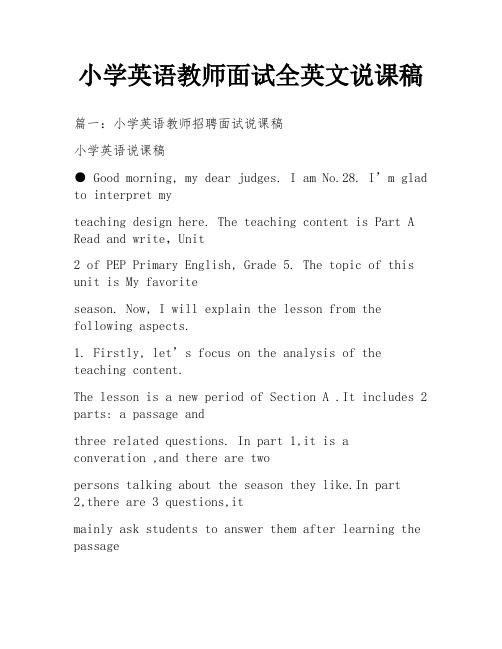
小学英语教师面试全英文说课稿篇一:小学英语教师招聘面试说课稿小学英语说课稿● Good morning, my dear judges. I am No.28. I’m glad to interpret myteaching design here. The teaching content is Part A Read and write,Unit2 of PEP Primary English, Grade 5. The topic of this unit is My favoriteseason. Now, I will explain the lesson from the following aspects.1. Firstly, let’s focus on the analysis of the teaching content.The lesson is a new period of Section A .It includes 2 parts: a passage andthree related questions. In part 1,it is aconveration ,and there are twopersons talking about the season they like.In part2,there are 3 questions,itmainly ask students to answer them after learning the passagecarefully,and it can help the students review the knowledge of this lesson.2. Secondly, it is about the students.Our students are in Grade 5. They are active, curious, and interested innew things. And they have already mastered some basic Englishbackground knowledge after learning English for several years. So theteacher should attach importance to the munication with them,providing them the chances of using languages.3.Thirdly, I set the following aims.By the end of the lesson, students will be able to read, recognize, and usethese words:And, these sentences:By the end of the lesson,Ss can understand the passage and get useful information from thepassage through attentive listening and reading.Ss can use the target language to make a new conversation according tothe passage.In this lesson, the emotional aims are:to foster Ss’ consciousness of good-cooperation and properpetitionto help Ss cultivate their abilities to analyze and solve problemsindependently.to make sure that Ss can use the target languages correctly and skillfully.to develop Ss’ interests in English.The difficult points are:The pronunciation of the new words and the use of the new sentences4.Fourthly, it talks about teaching methods.In this lesson, I will mainly use “Task-based teaching method”, “Communicative language teaching method” ,“TPR teaching method”, and so on.5.Fifthly, let’s focus on the teaching procedures.I will finish the lesson in five steps.It will cost about 5 mins.After greeting with the Ss, I will begin the lesson by singing the song together with the Ss in order to help them form a betterEnglish learning surrounding ,and it providessituations to review the learnt knowledge forthe next step at the same time.It will cost about 15 mins. Firstly, after teachingthe students the new words, I will encourage them to read the words by petition.We will praise the one who reads the fastest and the most accurate. Of course , I will never forget impart the knowledge ofpronunciation rules in teaching the new words. And then, turn to page 18,let’s focus on the passage. And I will ask them to underline the key sentences of the passage at the same time. After learning the passage , I will let them read after me in order to make them read it fluently. And I check them to read it in pairs. And then, let them answer the following questions of thepassage.It will cost 10 mins, due to the Ss’ age, I set a situation of the seasons by showing some pictures on the blackboard to let the students describe. I ask them to focus on the passage again to draw the whole Ss’ attention to the understanding of the passage,and let them to find the desciption words about the seasons as quickly as possible. And then, I encouragethem to put up their hands to write their answers on the blackboard. It will cost 7 mins. In this step, I will give Ss a free space to show their abilities.I will show the pictures again, and then let them discuss the topic in groups ,and encourage some groups to show their ideas in front of the class.The activity is to develop Ss’ abilities of munication, and also, their abilities of cooperation will be well developed. Making a new dialogue is to check if Ss can use the target languages correctly andskillfully. It will cost about 3 mins. In this step, I will guide the Ss to conclude what they learnt today and then , place the homework.6.Now, this is my blackboard design.That’s all for my teaching design. Thank you a lotfor listening. (GONG)篇二:小学英语教师招聘说课稿(全英文万能版)小学英语教师招聘说课稿(英文万能版)● Good morning, my dear judges. I am number_______. I’m glad tointerpret my teaching design here.● My teaching content today is Partof Unit of PEPPrimary English, Book This unit is mainly about Now, I will explain the lesson from the following aspects.1. 教学内容 (Contents)Firstly, let’s focus on the analysis of teaching content.The lesson is a new one of Unit .It includes , ____ and . In section 1, itmainly deals with these key words,2. 教学对象(talk about the students)Secondly, it is about the students.Our students are in GradeThey are active and curious, interested in new things.After learning English for years, they have some basic Englishbackground knowledge, so the teacher should attach importance to themunication with them, providing them the chances of using language.They have learnt English for years, and have already knownIt is not difficult for them to understand and use the language3. 教学目标 (Teaching aims)So, I set the following aims.By the end of the lesson, students will be able to read, recognize, and usethese words:And, these sentences:By the end of the lesson,①Ss can understand the and get useful information from the throughattentive listening / reading.②Ss are able to talk about③Ss can use to give suggestions on④Ss’ abilities of listening and speaking will be developed.(Affect;Learning strategies;cultural awareness.)In this lesson, the emotional aim is①to help students cultivate and foster theirabilities of working ingroups.②to foster Ss’ consciousness of good-cooperation and properpetition.③to help Ss cultivate their abilities to analyze and solve problemsindependently.④to foster Ss’ initiative and creativeness.⑤to help Ss to recognize and identify the differences between Chineseand English cultures on ⑥to help Ss know some and prehend the①to make sure that Ss can use Correctly andskillfully.to develop Ss’ inter est in English.②The difficult point is:The pronunciation of 4.教法学法(Teaching methods)Fourthly, it talks about teaching methods.In this lesson, I will mainly use “Task-based teaching method”,“Communicative language teaching method” and “TPR teaching met hod”,and so on.4. 教学过程① 具体steps 根据具体内容定;一般分为:warming up \ leadin\presentation\consolidation\homework②板书steps + purpose 说明;③如有可能,同时完成layout设计;Next, let’s focus on the teaching procedures.I will finish the lesson in steps.It will cost about mins.After greeting with the Ss, I will begin the lesson by singing the song together with the Ss.Purpose:The purpose of this is to form a better English learning surrounding forthe Ss, and, at the same time, it provides situations to review the learntknowledgefor the next step.It will cost about mins.With the help of the PPT, I set a situation of by to stimulate the Ss’ interest of the lesson.By playing the PPT, IAnd then, (板书layout)The purpose of this is to present the new words and sentences in thes ituation, which relates to the Ss’ real life experiences, to help the Ssunderstand the language easily and naturally.After presenting each new word (by the guessing game), I will impart theknowledge of pronunciation rules in teaching the new words.It is called Phonics.It can facilitate the Ss’ abilities to pronounce the words, and help them toremember the spelling of the words.(机械上口;有意义操练;let’s do;课文对话表演;)篇三:中学英语教师招聘面试全英文说课稿Good morning, everyone !I’m No.____ candidate. Nice to meet you! (鞠躬)Today my topic is about ________________________,(板书) I will analyze the lesson from the six parts.:analysis of teachingmaterial, teaching aims and demands, student analysis, teaching methods, learning methods and procedures. (下面我将从教材、教学目标和要求、学情、教法、学法、教学程序等几个方面进行说课。
小学英语教师招聘说课稿(全英文万能版)
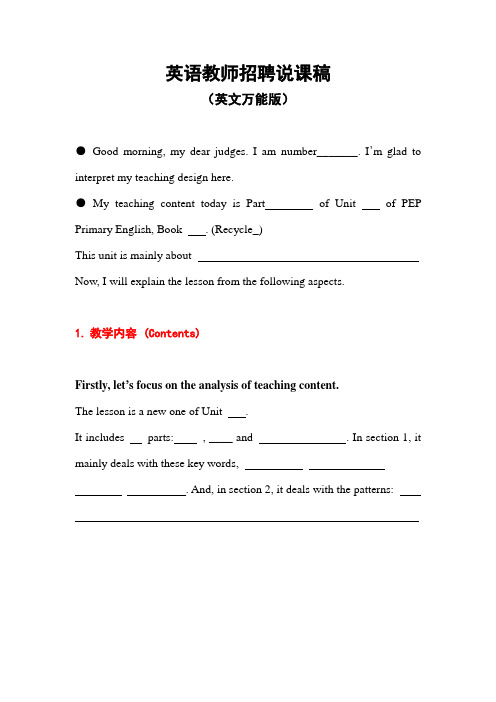
英语教师招聘说课稿(英文万能版)●Good morning, my dear judges. I am number_______. I’m glad to interpret my teaching design here.●My teaching content today is Part of Unit of PEP Primary English, Book . (Recycle_)This unit is mainly aboutNow, I will explain the lesson from the following aspects.1.教学内容 (Contents)Firstly, let’s focus on the analysis of teaching content.The lesson is a new one of Unit .It includes parts: , ____ and . In section 1, it mainly deals with these key words,. And, in section 2, it deals with the patterns:2.教学对象(talk about the students)Secondly, it is about the students.Our students are in Grade .They are active and curious, interested in new things.After learning English for years, they have some basic English background knowledge, so the teacher should attach importance to the communication with them, providing them the chances of using language. They have learnt English for years, and have already knownIt is not difficult for them to understand and use the language3.教学目标 (Teaching aims)So, I set the following aims.By the end of the lesson, students will be able to read, recognize, and use these words:And, these sentences:By the end of the lesson,①Ss can understand theand get useful information from the through attentive listening / reading.②Ss are able to talk about③Ss can useto give suggestions on④Ss’ abilities of listening and speaking will be developed.(Affect; Learning strategies; cultural awareness.)In this lesson, the emotional aim is①to help students cultivate and foster their abilities of working ingroups.②to foster Ss’consciousness of good-cooperation and propercompetition.③to help Ss cultivate their abilities to analyze and solve problemsindependently.④to foster Ss’ initiative and creativeness.⑤to help Ss to recognize and identify the differences between Chineseand English cultures on⑥to help Ss know some and comprehend the①to make sure that Ss can useCorrectly and skillfully. to develop Ss’ interest in English.②The difficult point is:The pronunciation of4.教法学法(Teaching methods)Fourthly, it talks about teaching methods.In this lesson, I will mainly use “Task-based teaching method”, “Communicative language teaching method” and “TPR teaching method”, and so on.4.教学过程①具体steps 根据具体内容定;一般分为:warming up \ lead in\presentation\consolidation\homework②板书steps+purpose 说明;③如有可能,同时完成layout设计;Next, let’s focus on the teaching procedures.I will finish the lesson in steps.It will cost about mins.After greeting with the Ss, I will begin the lesson by singing the songtogether with the Ss. Purpose:The purpose of this is to form a better English learning surrounding for the Ss, and, at the same time, it provides situations to review the learnt knowledgefor the next step.It will cost about mins.With the help of the PPT, I set a situation ofbyto stimulate the Ss’ interest of the lesson.By playing the PPT, IAnd then,(板书layout) The purpose of this is to present the new words and sentences in the situation, which relates to the Ss’real life experiences, to help the Ss understand the language easily and naturally.After presenting each new word (by the guessing game), I will impart the knowledge of pronunciation rules in teaching the new words.It is called Phonics.It can facilitate the Ss’ abilities to pronounce the words, and help them to remember the spelling of the words.(机械上口;有意义操练;let’s do; 课文对话表演;)It will cost mins, including 1 mechanical activity to help Ss to recognize and read the new words and sentences, and 2 activities in the meaningful situations to make Ss use the new words with sentence structures in , to help Ss use the language in a real situation.Due to the Ss’ age, I makeThe purpose of this is to draw the whole Ss’ attention to the spelling of the words.It is to help Ss to learnthrough a true situation.In this step, I will give Ss a free space to show their abilities.I willThen,Task-based teaching method and Communicative language teaching are used here.The activity is to develop Ss’ability of communication, and also, their ability of cooperation will be well developed.Making a new dialogue is to check if Ss can usecorrectly and skillfully.(总结上课内容;德育渗透;作业布置;)In this step, I will guide the Ss to conclude the key wordsAnd sentencesAnd also, I willThe purpose of this is to stimulate Ss’interest of learning English and wide their knowledge about communication across cultures.6.板书再次介绍(Talking about the blackboard design again)And, this is my layout design.That’s all for my teaching design. Thank you a lot for listening. (GONG)。
【英语】小学英语教师面试说课稿
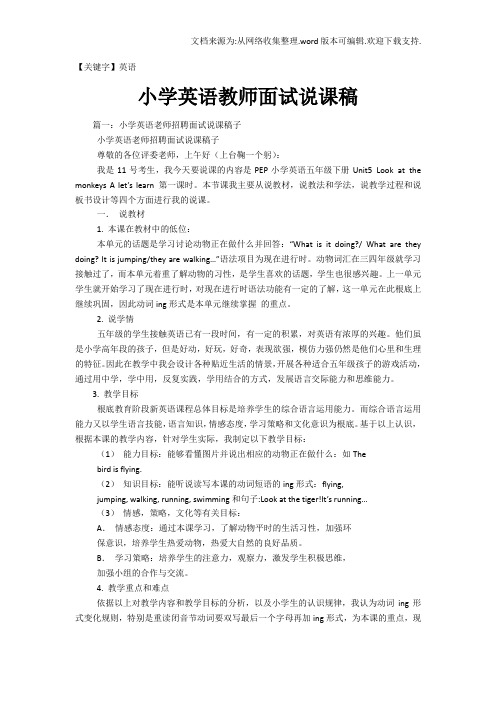
【关键字】英语小学英语教师面试说课稿篇一:小学英语老师招聘面试说课稿子小学英语老师招聘面试说课稿子尊敬的各位评委老师,上午好(上台鞠一个躬):我是11号考生,我今天要说课的内容是PEP小学英语五年级下册Unit5 Look at the monkeys A let’s learn 第一课时。
本节课我主要从说教材,说教法和学法,说教学过程和说板书设计等四个方面进行我的说课。
一.说教材1. 本课在教材中的低位:本单元的话题是学习讨论动物正在做什么并回答:“What is it doing?/ What are they doing? It is jumping/they are walking…”语法项目为现在进行时。
动物词汇在三四年级就学习接触过了,而本单元着重了解动物的习性,是学生喜欢的话题,学生也很感兴趣。
上一单元学生就开始学习了现在进行时,对现在进行时语法功能有一定的了解,这一单元在此根底上继续巩固,因此动词ing形式是本单元继续掌握的重点。
2. 说学情五年级的学生接触英语已有一段时间,有一定的积累,对英语有浓厚的兴趣。
他们虽是小学高年段的孩子,但是好动,好玩,好奇,表现欲强,模仿力强仍然是他们心里和生理的特征。
因此在教学中我会设计各种贴近生活的情景,开展各种适合五年级孩子的游戏活动,通过用中学,学中用,反复实践,学用结合的方式,发展语言交际能力和思维能力。
3. 教学目标根底教育阶段新英语课程总体目标是培养学生的综合语言运用能力。
而综合语言运用能力又以学生语言技能,语言知识,情感态度,学习策略和文化意识为根底。
基于以上认识,根据本课的教学内容,针对学生实际,我制定以下教学目标:(1)能力目标:能够看懂图片并说出相应的动物正在做什么:如Thebird is flying.(2)知识目标:能听说读写本课的动词短语的ing形式:flying,jumping, walking, running, swimming和句子:Look at the tiger!It’s running…(3)情感,策略,文化等有关目标:A.情感态度:通过本课学习,了解动物平时的生活习性,加强环保意识,培养学生热爱动物,热爱大自然的良好品质。
小学英语教师招聘说课稿(全英文万能版)
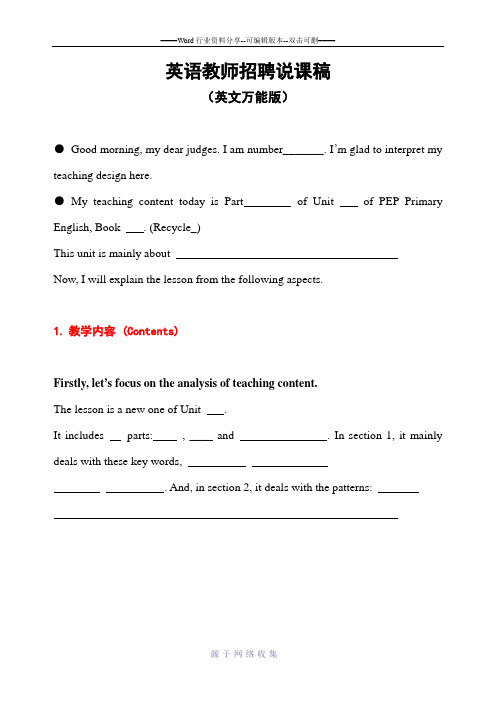
英语教师招聘说课稿(英文万能版)●Good morning, my dear judges. I am number_______. I’m glad to interpret my teaching design here.●My teaching content today is Part of Unit of PEP Primary English, Book . (Recycle_)This unit is mainly aboutNow, I will explain the lesson from the following aspects.1.教学内容 (Contents)Firstly, let’s focus on the analysis of teaching content.The lesson is a new one of Unit .It includes parts: , ____ and . In section 1, it mainly deals with these key words,. And, in section 2, it deals with the patterns:2.教学对象(talk about the students)Secondly, it is about the students.Our students are in Grade .They are active and curious, interested in new things.After learning English for years, they have some basic English background knowledge, so the teacher should attach importance to the communication with them, providing them the chances of using language.They have learnt English for years, and have already knownIt is not difficult for them to understand and use the language3.教学目标 (Teaching aims)So, I set the following aims.By the end of the lesson, students will be able to read, recognize, and use these words:And, these sentences:By the end of the lesson,①Ss can understand theand get useful information from the through attentive listening / reading.②Ss are able to talk about③Ss can useto give suggestions on④Ss’ abilities of listening and speaking will be developed.(Affect; Learning strategies; cultural awareness.)In this lesson, the emotional aim is①to help students cultivate and foster their abilities of working in groups.②to foster Ss’ consciousness of good-cooperation and proper competition.③to help Ss cultivate their abilities to analyze and solve problemsindependently.④to foster Ss’ initiative and creativeness.⑤to help Ss to recognize and identify the differences between Chinese andEnglish cultures on⑥to help Ss know some and comprehend the①to make sure that Ss can useCorrectly and skillfully.to develop Ss’ interest in English.②The difficult point is:The pronunciation of4.教法学法(Teaching methods)Fourthly, it talks about teaching methods.In this lesson, I will mainly use “Task-based teaching method”, “Communicative language teaching method” and “TPR teaching method”, and so on.4.教学过程①具体steps 根据具体内容定;一般分为:warming up \ lead in\presentation\consolidation\homework②板书steps+purpose 说明;③如有可能,同时完成layout设计;Next, let’s focus on the teaching procedures.I will finish the lesson in steps.It will cost about mins.After greeting with the Ss, I will begin the lesson by singing the songtogether with the Ss.Purpose:The purpose of this is to form a better English learning surrounding for the Ss, and, at the same time, it provides situations to review the learnt knowledgefor the next step.It will cost about mins.With the help of the PPT, I set a situation ofbyto stimulate the Ss’ interest of the lesson.By playing the PPT, IAnd then,(板书layout) The purpose of this is to present the new words and sentences in the situation, which relates to the Ss’real life experiences, to help the Ss understand the language easily and naturally.After presenting each new word (by the guessing game), I will impart the knowledge of pronunciation rules in teaching the new words.It is called Phonics.It can facilitate the Ss’abilities to pronounce the words, and help them to remember the spelling of the words.(机械上口;有意义操练;let’s do; 课文对话表演;)It will cost mins, including 1 mechanical activity to help Ss to recognize and read the new words and sentences, and 2 activities in the meaningful situations to make Ss use the new words with sentence structures in , to help Ss use the language in a real situation.Due to the Ss’ age, I makeThe purpose of this is to draw the whole Ss’ attention to the spelling of the words.It is to help Ss to learnthrough a true situation.In this step, I will give Ss a free space to show their abilities.I willThen,Task-based teaching method and Communicative language teaching are used here.The activity is to develop Ss’ ability of communication, and also, their ability of cooperation will be well developed.Making a new dialogue is to check if Ss can usecorrectly and skillfully.(总结上课内容;德育渗透;作业布置;)In this step, I will guide the Ss to conclude the key wordsAnd sentencesAnd also, I willThe purpose of this is to stimulate Ss’ interest of learning English and wide their knowledge about communication across cultures.6.板书再次介绍(Talking about the blackboard design again)And, this is my layout design.That’s all for my teaching design. Thank you a lot for listening. (GONG)。
小学英语面试说课稿

小学英语面试说课稿(经典版)编制人:__________________审核人:__________________审批人:__________________编制单位:__________________编制时间:____年____月____日序言下载提示:该文档是本店铺精心编制而成的,希望大家下载后,能够帮助大家解决实际问题。
文档下载后可定制修改,请根据实际需要进行调整和使用,谢谢!并且,本店铺为大家提供各种类型的经典范文,如工作报告、规章制度、应急预案、条据书信、合同协议、评语大全、演讲致辞、心得体会、教学资料、其他范文等等,想了解不同范文格式和写法,敬请关注!Download tips: This document is carefully compiled by this editor. I hope that after you download it, it can help you solve practical problems. The document can be customized and modified after downloading, please adjust and use it according to actual needs, thank you!Moreover, our store provides various types of classic sample texts, such as work reports, rules and regulations, emergency plans, policy letters, contract agreements, comprehensive reviews, speeches, insights, teaching materials, and other sample texts. If you want to learn about different sample formats and writing methods, please pay attention!小学英语面试说课稿小学英语面试说课稿(通用10篇)作为一位不辞辛劳的人·民教师,时常要开展说课稿准备工作,借助说课稿可以有效提高教学效率。
小学英语教师招聘面试说课稿
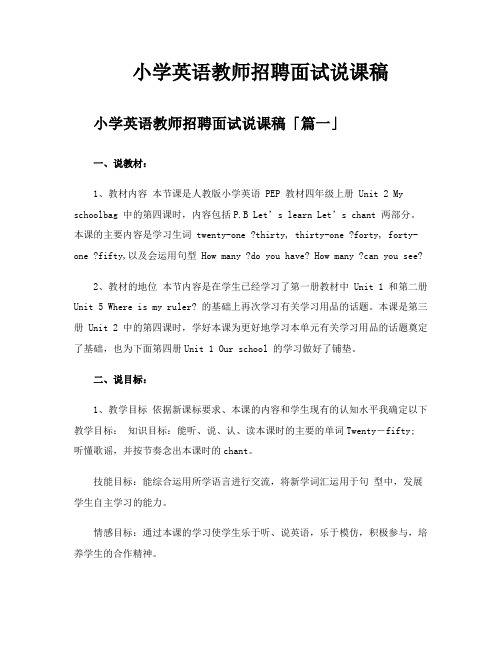
小学英语教师招聘面试说课稿小学英语教师招聘面试说课稿「篇一」一、说教材:1、教材内容本节课是人教版小学英语 PEP 教材四年级上册 Unit 2 My schoolbag 中的第四课时,内容包括P.B Let’s learn Let’s chant 两部分。
本课的主要内容是学习生词 twenty-one ?thirty, thirty-one ?forty, forty-one ?fifty,以及会运用句型 How many ?do you have? How many ?can you see?2、教材的地位本节内容是在学生已经学习了第一册教材中 Unit 1 和第二册Unit 5 Where is my ruler? 的基础上再次学习有关学习用品的话题。
本课是第三册 Unit 2 中的第四课时,学好本课为更好地学习本单元有关学习用品的话题奠定了基础,也为下面第四册Unit 1 Our school 的学习做好了铺垫。
二、说目标:1、教学目标依据新课标要求、本课的内容和学生现有的认知水平我确定以下教学目标:知识目标:能听、说、认、读本课时的主要的单词Twenty―fifty; 听懂歌谣,并按节奏念出本课时的chant。
技能目标:能综合运用所学语言进行交流,将新学词汇运用于句型中,发展学生自主学习的能力。
情感目标:通过本课的学习使学生乐于听、说英语,乐于模仿,积极参与,培养学生的合作精神。
2、教学重难点本课的重点是掌握单词 twenty-one?thirty, thirty-one? forty, forty-one?fifty,做到能听、说、认、读,听懂歌谣,并按节奏念出本课时的chant。
难点是将新学词汇运用于句型How many?do you have? I have? 中,联系生活来运用及交流。
以及thirteen 与thirty, fourteen 与 forty, fifteen 与fifty.的发音。
小学英语教师证面试说课稿
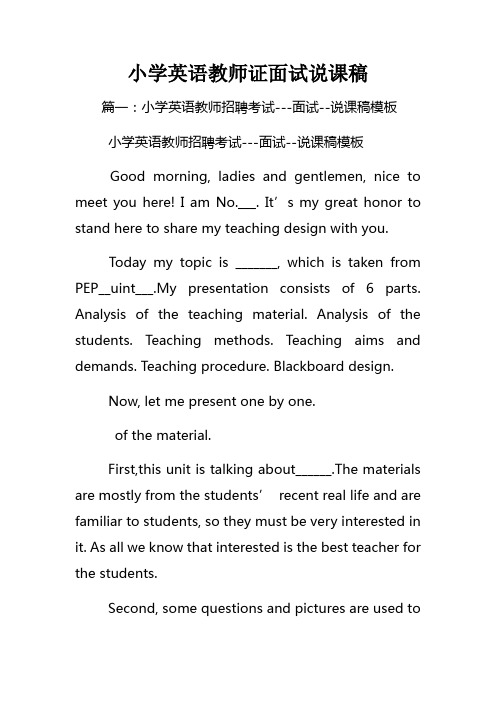
Activities will help Ss to recognize and read the new words and sentences, Due to the Ss’ age, I make a role-paly game to make Ss use the new words with sentence structure and make a conversationwith their partners.
The difficulty is to help the Ss make conversations freely by using the target language.
teaching aids.
A tape recorder and a computer will be used in this lesson.
aims. in this lesson, the students should masterthe new words._____ ___and the key sentence ______. Meanwhile, they should know how to express themselves and communicate with others with these
小学英语教师证面试说课稿
篇一:小学英语教师招聘考试---面试--说课稿模板
小学英语老师招聘面试说课稿子

小学英语老师招聘面试说课稿子尊敬得各位评委老师,上午好(上台鞠一个躬):我就是11号考生,我今天要说课得内容就是PEP小学英语五年级下册Unit5 Look at the monkeys A let’s learn 第一课时。
本节课我主要从说教材,说教法与学法,说教学过程与说板书设计等四个方面进行我得说课。
一.说教材1.本课在教材中得低位:本单元得话题就是学习讨论动物正在做什么并回答:“What is itdoing?/ What are they doing? It isjumping/they are walking…”语法项目为现在进行时。
动物词汇在三四年级就学习接触过了,而本单元着重了解动物得习性,就是学生喜欢得话题,学生也很感兴趣。
上一单元学生就开始学习了现在进行时,对现在进行时语法功能有一定得了解,这一单元在此基础上继续巩固,因此动词ing形式就是本单元继续掌握得重点。
2.说学情五年级得学生接触英语已有一段时间,有一定得积累,对英语有浓厚得兴趣。
她们虽就是小学高年段得孩子,但就是好动,好玩,好奇,表现欲强,模仿力强仍然就是她们心里与生理得特征。
因此在教学中我会设计各种贴近生活得情景,开展各种适合五年级孩子得游戏活动,通过用中学,学中用,反复实践,学用结合得方式,发展语言交际能力与思维能力。
3.教学目标基础教育阶段新英语课程总体目标就是培养学生得综合语言运用能力。
而综合语言运用能力又以学生语言技能,语言知识,情感态度,学习策略与文化意识为基础。
基于以上认识,根据本课得教学内容,针对学生实际,我制定以下教学目标:(1)能力目标:能够瞧懂图片并说出相应得动物正在做什么:如Thebird is flying、(2)知识目标:能听说读写本课得动词短语得ing形式:flying, jumping, walking,running,swimming与句子:Look at the tiger!It’s running…(3)情感,策略,文化等有关目标:A.情感态度:通过本课学习,了解动物平时得生活习性,加强环保意识,培养学生热爱动物,热爱大自然得良好品质。
小学英语教师面试说课稿(英文版)
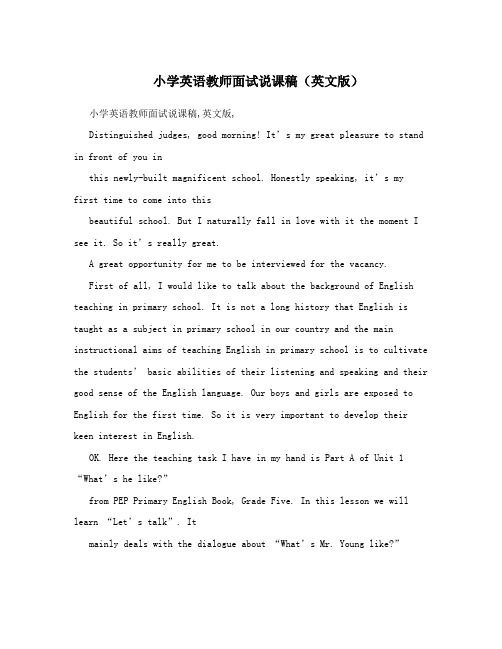
小学英语教师面试说课稿(英文版)小学英语教师面试说课稿,英文版,Distinguished judges, good morning! It’s my great pleasure to stand in front of you inthis newly-built magnificent school. Honestly speaking, it’s myfirst time to come into thisbeautiful school. But I naturally fall in love with it the moment I see it. So it’s really great.A great opportunity for me to be interviewed for the vacancy.First of all, I would like to talk about the background of English teaching in primary school. It is not a long history that English is taught as a subject in primary school in our country and the main instructional aims of teaching English in primary school is to cultivate the students’ basic abilities of their listening and speaking and their good sense of the English language. Our boys and girls are exposed to English for the first time. So it is very important to develop their keen interest in English.OK. Here the teaching task I have in my hand is Part A of Unit 1 “What’s he like?”from PEP Primary English Book, Grade Five. In this lesson we will learn “Let’s talk”. Itmainly deals with the dialogue about “What’s Mr. Young like?”The teaching objective of this class is to enable the Ss to understand and express the sentence patterns: Is he young? Is he funny? Yes, he is. No, he isn’t. Who is your Englishteacher? Make sure that Ss can use these sentences in real situations.The Ss also need to know how to listen, read, and use these adjectives: “quiet,hard-working, clever, polite, kind, strict, young, old, funny, tall, friend ly”. In addition,make sure the students are familiar with these adjectives and canuse them to describe a person.I think by completing the teaching task, the Ss will increase their interest and set up self-confidence in English study. And by describing our own teachers, the students can know more about our teachers, and it can help the teachers and the students to build good relationships.Well, how to achieve the teaching objectives better? The key is how to make use of the proper teaching methods; I’ll talk about my teaching methods below. I adoptTBLT method in my teaching, namely Task-based Language Teaching.That is to say, I will let the Ss learn in real situations and finish a task to help the Ss to get a better understanding of the key structure of the dialogue. At the same time, make use of CAI and all kinds of teaching means; it can mobilize the Ss’ enthusiasm and creativity in learning English.I will divide the teaching process into four steps.In the beginning of my class there will be warm-up and preview. Asis known to all, well begun is half done. It is necessary to have a free talk about the appearance and character of their friends. It can make Ss feel pleased and relaxed, and can attract their attention. I will leadin this lesson by asking the following question: Good morning, boys and girls. During the summer holiday, I think you probably make a new friend. Who is he? What is he like? Is he funny? Is he clever?And afterwards, I probably have them do some word games. For example, I will show the students some pictures of different people. And I want them to tell me the adjectives that come to their mind. The more, the better. For example, I may show them a picture of a fashion girl, andthey can tell me the adjectives like beautiful, smart. But this partwill not be too long. I guess that maybe 5-7mins will be enough for that.The next step is presentation. With the help of the CAI I willpresent the dialogue in rt one. And then I would like to give students some kind of exercises, such as T/F, match, pamultiple choices or even some kind of table for students to fill in.By completing the task, I can check if they understand the dialogue properly. Then I will make the Ss to read the sentences after me. Make sure they can say it correctly. Pay attention to their pronunciation and intonation.After they are familiar with the sentence patterns, we can play a guessing game. Divide the whole class into four groups to have acompetition. The teacher or some students come up to the platform to describe a student in our class. For example, he is thin. He is tall. He is clever. Do you know who he is? Proper competition can arouse the Ss’ interest in English learning. We can achieve the aim of consolidatingthesentence pattern in a relaxed atmosphere.The third step is practice. I still adopt the “Task-based”teaching method. Thetask is talking about your friends, teachers and your family members using the sentence patterns: My friend is Jack. He is clever. He is kind. Students are asked to participate fully in the discussion and sharetheir opinions with each other freely. They can use the opportunity to practice their spoken English. After the discussion, I’d like to ask them to come up to the platform and introduce the friends, teachers and parents of theirs. The purpose of this is to encourage the students to communicate with others and show themselves bravely.After that, here comes the review time. Revision is very important.It is necessary for the students to do some extensive exercises at the end of the class and after class to consolidate the knowledge they learned.As teachers, to make our English classrooms shine with vitality, we have a heavy burden, and we still have a long way to go. So I will try my best to give the student s a colorful and interesting class. That’s all. Thank you.。
教师资格证面试通用版小学英语说课稿
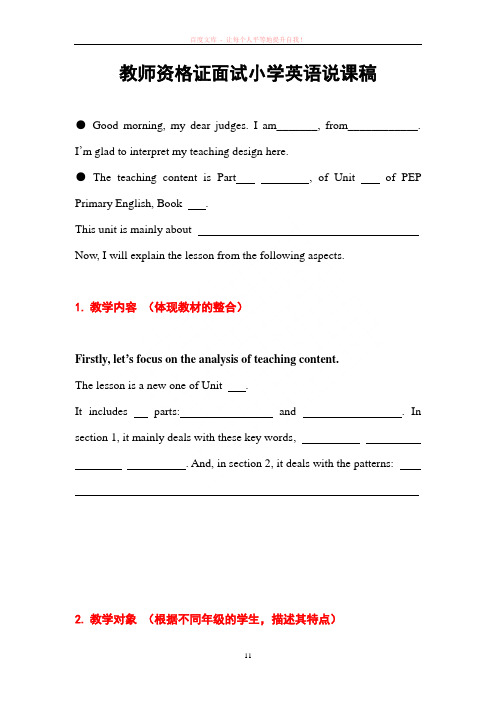
教师资格证面试小学英语说课稿●Good morning, my dear judges. I am_______, from____________. I’m glad to interpret my teaching design here.●The teaching content is Part , of Unit of PEP Primary English, Book .This unit is mainly aboutNow, I will explain the lesson from the following aspects.1.教学内容(体现教材的整合)Firstly, let’s focus on the analysis of teaching content.The lesson is a new one of Unit .It includes parts: and . In section 1, it mainly deals with these key words,. And, in section 2, it deals with the patterns:2.教学对象(根据不同年级的学生,描述其特点)Secondly, it is about the students.Our students are in Grade .They are active and curious, interested in new things.After learning English for years, they have some basic English background knowledge, so the teacher should attach importance to the communication with them, providing them the chances of using language. They have learnt English for years, and have already knownIt is not difficult for them to understand and use the language3.教学目标(根据具体内容定目标和要求)So, I set the following aims.①The first one is language knowledge.By the end of the lesson, students will be able to read, recognize, and use these words:And, these sentences:②The second one is language skills.By the end of the lesson,Ss can understand theand get useful information from the through attentive listening / reading.Ss are able to talk aboutSs can useto give suggestions onSs’ abilities of listening and speaking will be developed.③The third one is emotional aim.(Affect; Learning strategies; cultural awareness.)In this lesson, the emotional aim isto help students cultivate and foster their abilities of working in groups.to foster Ss’consciousness of good-cooperation and proper competition.to help Ss cultivate their abilities to analyze and solve problems independently.to foster Ss’ initiative and creativeness.to help Ss to recognize and identify the differences between Chinese and English cultures onto help Ss know some and comprehend the④And, the main point of this lesson is:to make sure that Ss can useCorrectly and skillfully.to develop Ss’ interest in English.The difficult point is:The pronunciation of4.教法学法Fourthly, it talks about teaching methods.In this lesson, I will mainly use “Task-based teaching method”, “Communicative language teaching method” and “TPR teaching method”, and so on.5.教学过程①具体steps 根据具体内容定;②板书steps+purpose 说明;③如有可能,同时完成layout设计;Step 1 LayoutNext, let’s focus on the teaching procedures.I will finish the lesson in steps.Step 1. Greeting and Warming-upIt will cost about mins.After greeting with the Ss, I will begin the lesson by singing the songtogether with the Ss.Purpose:The purpose of this is to form a better English learning surrounding for the Ss, and, at the same time, it provides situations to review the learnt knowledgefor the next step.Step 2. PresentationIt will cost about mins.With the help of the PPT, I set a situation ofbyto stimulate the Ss’ interest of the lesson.By playing the PPT, IAnd then,(板书layout) The purpose of this is to present the new words and sentences in the situation, which relates to the Ss’real life experiences, to help the Ss understand the language easily and naturally.After presenting each new word (by the guessing game), I will impart the knowledge of pronunciation rules in teaching the new words.It is called Phonics.It can facilitate the Ss’ abilities to pronounce the words, and help them to remember the spelling of the words.Step3. Practice(机械上口;有意义操练;let’s do; 课文对话表演;)It will cost mins, including 1 mechanical activity to help Ss to recognize and read the new words and sentences, and 2 activities in the meaningful situations to make Ss use the new words with sentence structures in , to help Ss use the language in a real situation.Due to the Ss’ age, I makeThe purpose of this is to draw the whole Ss’ attention to the spelling of the words.It is to help Ss to learnthrough a true situation.Step 4. DevelopmentIn this step, I will give Ss a free space to show their abilities.I willThen,Task-based teaching method and Communicative language teaching are used here.The activity is to develop Ss’ability of communication, and also, their ability of cooperation will be well developed.Making a new dialogue is to check if Ss can usecorrectly and skillfully.Step 5. Conclusion(总结上课内容;德育渗透;作业布置;)In this step, I will guide the Ss to conclude the key wordsAnd sentencesAnd also, I willThe purpose of this is to stimulate Ss’interest of learning English and wide their knowledge about communication across cultures.6.板书设计百度文库- 让每个人平等地提升自我!And, this is my layout design.That’s all for my teaching design. Thank you a lot for listening. (GONG)1111。
小学英语面试说课稿
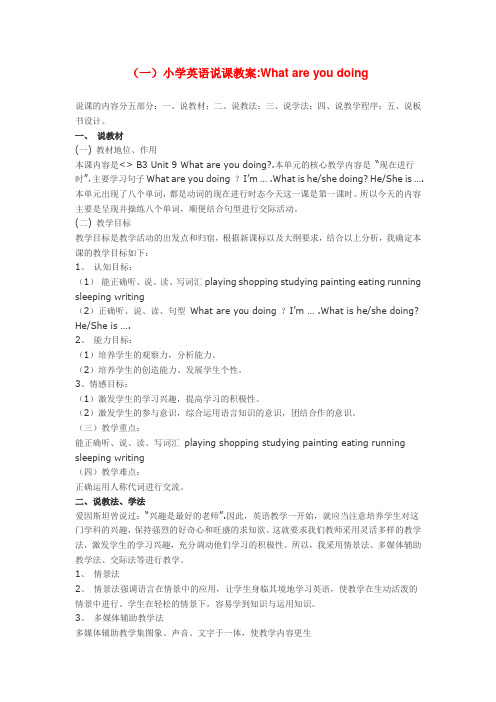
(一)小学英语说课教案:What are you doing说课的内容分五部分:一、说教材;二、说教法;三、说学法;四、说教学程序;五、说板书设计。
一、说教材(一) 教材地位、作用本课内容是<> B3 Unit 9 What are you doing?.本单元的核心教学内容是“现在进行时”,主要学习句子What are you doing ?I’m … .What is he/she doing? He/She is …. 本单元出现了八个单词,都是动词的现在进行时态今天这一课是第一课时。
所以今天的内容主要是呈现并操练八个单词,顺便结合句型进行交际活动。
(二) 教学目标教学目标是教学活动的出发点和归宿,根据新课标以及大纲要求,结合以上分析,我确定本课的教学目标如下:1、认知目标:(1)能正确听、说、读、写词汇playing shopping studying painting eating running sleeping writing(2)正确听、说、读、句型What are you doing ?I’m … .What is he/she doing? He/Sh e is ….2、能力目标:(1)培养学生的观察力,分析能力。
(2)培养学生的创造能力、发展学生个性。
3、情感目标:(1)激发学生的学习兴趣,提高学习的积极性。
(2)激发学生的参与意识,综合运用语言知识的意识,团结合作的意识。
(三)教学重点:能正确听、说、读、写词汇playing shopping studying painting eating running sleeping writing(四)教学难点:正确运用人称代词进行交流。
二、说教法、学法爱因斯坦曾说过:“兴趣是最好的老师”.因此,英语教学一开始,就应当注意培养学生对这门学科的兴趣,保持强烈的好奇心和旺盛的求知欲。
这就要求我们教师采用灵活多样的教学法,激发学生的学习兴趣,充分调动他们学习的积极性。
- 1、下载文档前请自行甄别文档内容的完整性,平台不提供额外的编辑、内容补充、找答案等附加服务。
- 2、"仅部分预览"的文档,不可在线预览部分如存在完整性等问题,可反馈申请退款(可完整预览的文档不适用该条件!)。
- 3、如文档侵犯您的权益,请联系客服反馈,我们会尽快为您处理(人工客服工作时间:9:00-18:30)。
To help students learn better, I will mainly adopt pictures and tape recorder as teaching aids.
VII. The analysis of teaching Procedure
II. The analysis of students
Next is the second part--the analysis of students. The students are in this period have learnt some basic English skills such as listening and speaking, but not very well. In addition, they are full of curiosity and very active . So I will give them lots of opportunities to practice in the class.
2017重庆教师招聘面试指导:小学英语说课稿
Good morning, honorable judges! I’m No. X. It’s my pleasure to stand here to interpret my design. My topic is“XX”. I will talk about my class from the parts as followed: the analysis of the material, teaching aims, key points and difficult points, teaching procedures and so on.
Knowledge aims: students should master the new words such as doctor, scientists and so on. And the sentence“What professions do you like?”
Ability aims: students can use the new words and sentence to communicate with others. Their listening and speaking skills can be improved.
III. The analysis of teaching aims
The third part is the analysis of teaching aims. According to the syllabus and the analysis of material and students, I want to explain my teaching aims from three aspects:
The second step is pre-listening. I will play a song for students called“What you wanna be?”, which can students relaxed because it is a pop song. Meanwhile, I will ask students“what is our lesson about? Can you guess?”Then it comes to our topic today“professions”.
Next, it’s the fourth step, post-listening. In this process, there are some practice activities. I will encourage students to work in pairs to make a new conversation in 3 minutes. Then I will call some representatives to show. Then another activities. I will guide students to discuss in group of four and make a new performance according to the knowledge we have learned and invite some students to act it out in five minutes. This activity can guide students to master the new knowledge much easier and more deeply. In the whole lesson, I will encourage students to open their mouth to improve confidence in speaking English.
After the above analysis, I want to explain the main part in my teaching design, the analysis of teaching procedures. I will talk about it from the following parts: warming-up, pre-listening, while-listening, post-listening, summary and homework.
I. The analysis of teaching material
Now let’s come to the first part--the analysis of teaching material. Unit 2 Junior School Grade 7, which is published by PEP . The main topic is about the professions in our daily life. It’s the listening and speaking lesson. It is very common, so it will be very useful and helpful for students.
VIII. The analysis of blackboard design
Finally, my blackboard design is the last part. I will write the new words and phrases on the left. And key patterns are the right, which can help students to master the knowledge better. For students, it’s very clear.
Emotional aims: After this class, students will understand all kinds of professions and have their own dreams.
IV. The analysis of teaching key point and difficult point
After warming-up, let’s move to the next step while-listening. In this step, I will let students listen to the tape for two times. The first time, I will ask students to get the main idea of this conversation. For the second time, Students should finish the exercise 1. For example,“what professions do you like?”“I like doctor.”In this way, students can know how to talk about professions in daily excommunication
Thank you.That’s all for my teaching design.
V. The analysis of teaching methods
And the next part is analysis of teaching methods and studying methods. I will adopt communicative Approach and task-based teaching method. As for studying method, autonomous learning method and cooperative learning method are mainly used. In this way, students will be the host of the class.
The last step is summary and homework. I will sum up the knowledge we have learned together with students. About the homework, I will make students search on line to collect other professions and share them next class. It will help students horizon their sight and develop the habit of learning English.
The first step is warming-up. I will let students chant with me to review the words about colors.‘Green, green, yellow, yellow, blue, blue, white white’It can arouse students’interest in this lesson. It’s good for me to start the next stage.
